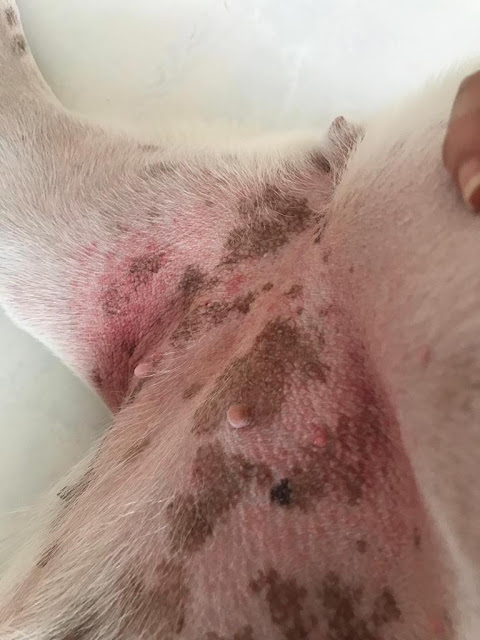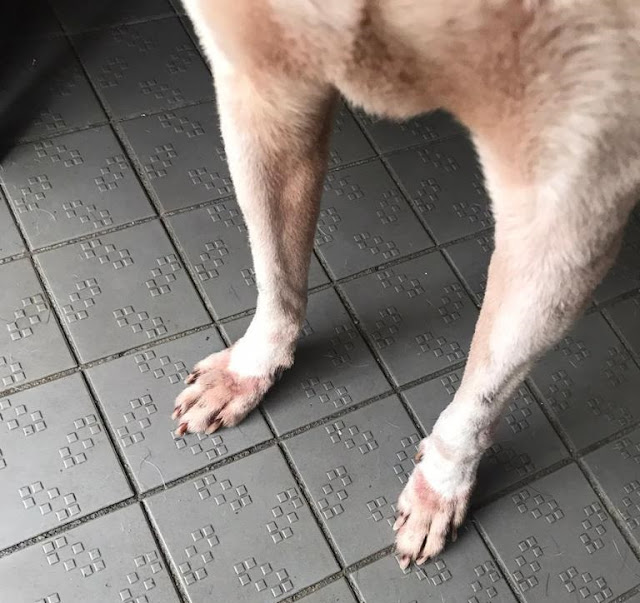Have you ever noticed your dog excessively scratching itself or licking its paw? This could be a sign that your furry friend is allergic to something in its environment! Unfortunately, allergic reactions in dogs have been on the rise in the past decade- having a sharp increase from 2019 onwards.
Inhalant and Skin Contact Allergies
Allergic reactions occur when a foreign particle (allergen) causes an overreaction of the immune system, leading to inflammation, which manifests as redness, swelling and itching. There are 2 ways a dog can be affected by the allergens in their surroundings- by inhaling and skin contact. Such allergies tend to be hereditary in nature. Therefore, they are, sadly, difficult to avoid. They often first show up when a dog is 6 months to 3 years old. You might notice allergies are seasonal, or that they get better or worse if you move to a new place. Most breeds of dogs are affected by this condition. Breeds that are more susceptible include Bichon Frises, Bulldogs, Chinese Shar-Peis, Cocker Spaniels, Retriever and Terrier Breeds, Shih Tzus and Lhasa Apsos.
Common Allergens
A very large number of substances can act as allergens. Most are proteins of insect, plant, or animal origin. Small chemical molecules can also cause allergic reactions. Examples of common allergens are grass or tree pollen, fungal or mould spores, dust mites, dander (dead skin flakes), insect proteins such as those in flea saliva, and some medications.
Unexpectedly, some fabrics can cause reactions. This is because manufacturing synthetic fabrics requires chemicals and processing. These chemicals, such as flame retardants, are known to be allergenic. Some fabrics also allow the accumulation of dust mites, mould, mildew and bacteria that can exacerbate skin sensitivity. To know more about which fabrics one should look out for, please refer to the tips section of this blogpost.
Harsh cleaning solutions (eg. bleach and Dettol) should also be avoided as they contain chemicals toxic to your furry friend. Your pet will end up ingesting these substances when they lick the floor or their paws! Not to mention, they may even breathe in toxic vapours produced from these cleaners, causing them respiratory problems. To know more about which cleaning agents one should use or avoid, please refer to the tips section of this blogpost.
Please also note that some essential oils and liquid potpourri are toxic to your pet and can lead to poisoning! They have chemicals that are rapidly absorbed orally or through the skin which are metabolised through the liver. Therefore, puppies and dogs with liver disease are more sensitive to such chemicals. While exposure to low amounts only result in gastrointestinal upset, certain concentrated oils can affect the liver (eg. pennyroyal oil), and the nervous system (eg. tea tree oil). They also irritate or burn the skin and mouth. Even a small amount could be harmful to our precious companions. To know more about which essential oils to avoid, please refer to the tips section of this blogpost.
Symptoms
Symptoms can appear anywhere on your dog’s body. The symptoms mentioned above are the common ones to look out for in your furry friend. In general, your pet may show signs of irritation on their skin (eg. scratching or licking) or irritation in their respiratory tract (eg. runny nose and sneezing). If you observe any of these symptoms (could be one or more), especially if they happen frequently, it is enough to consider allergies as a possible cause. Most importantly, it’s best to visit your vet to properly diagnose and treat your furry friend.
Practical tips
Wipe your dog’s paws and belly with a clean cloth after their walks to remove pollen and other allergens.
Use skin ointments or creams for small flare ups. Check with your vet for safe options.
During flare ups, use pet allergy shampoo with soothing aloe and oatmeal, or medicated with allergy-relieving ingredients.
For fabrics for your pet’s bedding, avoid wool, synthetic fabric and those with vinyl coating. Instead, use 100% cotton or hemp which are natural materials, tightly woven microfibre and textured nylon.
For cleaning agents, use natural products such as baking soda, vinegar and lemon juice. To find out the detailed list of chemicals and cleaning products to avoid, please navigate to this page: https://www.rover.com/blog/uk/pet-safe-cleaning/
For essential oils, avoid Citrus, Pennyroyal, Pine, Tea Tree and Ylang Ylang oils. Instead, use Chamomile, Frankincense, Ginger, Lavender, Myrrh and Peppermint oil. To find out the benefits these oils will bring to your dog, please navigate to this page: https://wildearth.com/blogs/dog-knowledge/what-essential-oils-are-safe-for-dogs/
Let’s work together to be informed and create a safe & comfortable environment for our furry friends at home! ❤️
Sources:
https://www.banfield.com/en/about-banfield/newsroom/press-releases/2021/banfield-pet-hospital-data-shows-increase-in-care-for-pets-in-2020-despite-pandemic
https://vcahospitals.com/know-your-pet/allergy-general-in-dogs
https://www.thisdogslife.co/10-breeds-prone-allergies/
https://bondvet.com/b/allergies-in-dogs-common-allergens-treatment
https://www.petmd.com/dog/general-health/can-dogs-be-allergic-their-beds
https://kuranda.com/faq/dog-bed-fabrics-for-dogs-with-allergies
https://vcahospitals.com/know-your-pet/essential-oil-and-liquid-potpourri-poisoning-in-dogs
Written by : Jewel Wee



















